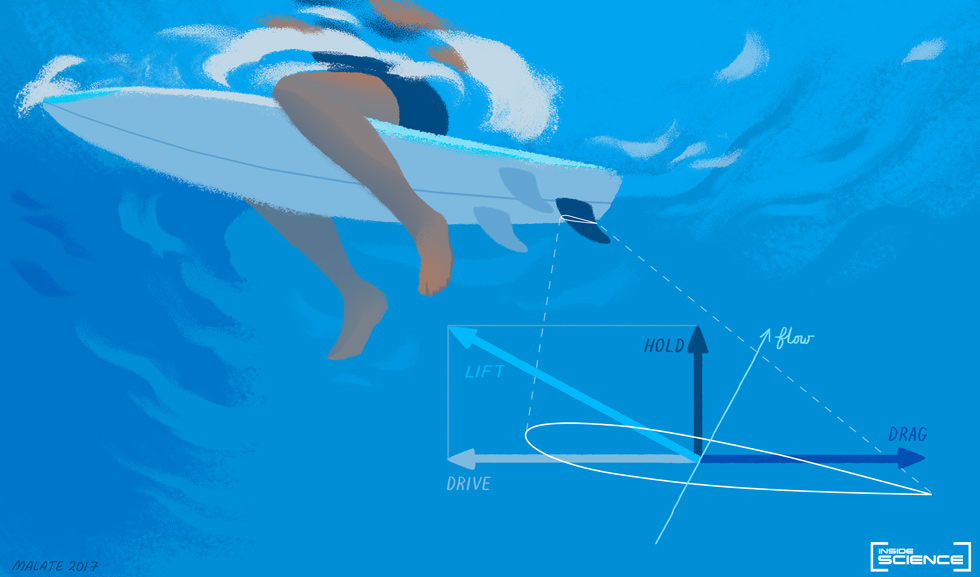Using Math to Make More ‘Uplifting’ Surfboard Fins
(Inside Science) -- More people are hitting the beach with surfboards in tow these days. The Surf Industry Manufacturers Association estimates there were 2.5 million surfers in the U.S. alone in 2016, a 40 percent increase since 2004. And as popularity and professionalism in surfing has grown, so has scientific interest in the sport.
Recently, a research team from the U.K.’s Cranfield University has employed mathematical models to optimize surfboard fins. Their findings were published online in the Journal of Sports Engineering and Technology in May.
Surfboard fin manufacturers and sellers are often considered to be out of touch with the science behind their products. “It’s more, ‘this pro surfs with this fin, so we’re putting this in the shop’” said Marc in het Panhuis, a veteran surfer and professor of materials science who leads a team at the University of Wollongong in Australia that makes customized 3-D printed surfboard fins. He was not involved in the study.
To help make surfboard design more scientific, the Cranfield University research team aimed to highlight how fluid dynamics can be used to model a peak performance fin.
Although a perfect one-size-fits-all fin doesn’t exist, surfers look for fins that help them both accelerate and maneuver easily through the water. Surfers often refer to these two forces as “drive” and “hold.” A fin’s drive propels the board faster while its hold grips the wave and gives the surfer more control.
Scientists have their own word for this compound feeling of acceleration and control: “lift.”
Lift occurs when a fluid buffets against an object at an angle, like water against a surfboard fin. The side that faces the direction of flow experiences higher pressure while its opposite encounters lower pressure. This pressure difference then propels the object away from the area of high pressure and towards low pressure, resulting in lift. This force is responsible for mobilizing sailboats across water, airplanes through the sky, and even surfers through crashing waves.
Meanwhile, a competing force called “drag” works counteractive to lift, decelerating an object. Fins that capitalize on lift while reducing drag are thus highly sought after by surfers looking to improve their shred.
Zeeshan Rana is a professor at Cranfield University’s Centre for Computational Engineering Sciences and co-author of the study. He has never set foot on a surfboard, but with a doctorate in computational fluid dynamics and aerospace sciences, he’s an expert on lift and drag.
Rana and his team claim that ocean currents push and pull surfboard fins similar to how air carries airplane wings. By applying mathematical modeling techniques he uses for aerodynamics research, Rana and his co-authors sought to model a fin that generates the most amount of lift with the least amount of drag.
The researchers began with a generic surfboard fin design virtually constructed from an earlier study. They then measured the lift-to-drag ratio of this fin by running it through computer simulations commonly used for aerodynamics research.
They gradually improved the lift-to-drag ratio of their virtual fin by changing its shape, altering measurements like its thickness, depth, length and base shape, and the angle of its curve. The researchers ran each new design through simulations to see how the ratio changed. After 42 different iterations, Rana and his colleagues had modeled a fin with a 14.32 lift-to-drag ratio, approximately a 62 percent improvement from their initial design.
The final design doesn’t look drastically different from other surfboard fins to the naked eye, and Rana expects that this model would only make slight improvements to surfing performance. However, he believes that on a professional level, the most minute differences can sometimes make the biggest impact. For example, in the case of cricket, Rana claims that minor differences in throwing arms helped make ballers like Wasim Akram legends in their field. “The way [Akram] threw the ball has been investigated quite extensively in fact, and they think that it was [a] natural flaw in his arm,” he said.
Rana acknowledges that their model is still very basic since they only optimized their fins for a certain angle and speed. Due to the nature of hydrodynamics, as factors like speed and angle change, so would optimal fin shape.
Still, this kind of specified optimization could be helpful for fin customization, a service that in het Panhuis believes the surfboard fin industry often lacks. “What I find is that, as a surfer, you try to match your surfboard to the fins that are available,” he said.
According to in het Panhuis, Rana's computation approach is useful for surfboard fin design. His own team also uses computational fluid dynamics, or CFD, to optimize their surfboard fins before printing. However, he argues that these designs would still need to be tested in the ocean. His team collaborates with six trial surfers who measure fin performance data with sensors as well as give qualitative feedback.
“CFD is fantastic and provides a good starting point, but it’s that feedback loop -- actual testing in the ocean - that then needs to be closed back up to provide the most optimal fin for a particular surfer,” he said.



